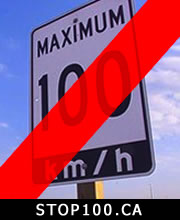 In response to: “Three minor crashes on same stretch of highway” http://www.
In response to: “Three minor crashes on same stretch of highway” http://www.
On Saturday, Dec. 8, it was reported that three separate crashes occurred on the same section of freeway near St. Catherines during wet road conditions. The limit on that stretch drops to 80 from 100 km/h to warn motorists to slow down ahead of a dangerous curve. Unfortunately, this warning is often ignored.
OPP sergeant Jan Idzenga was quoted saying that people are simply “refusing to slow down” to 80 km/h in than zone and “routinely travel […] in excess of 100 km/h,” and consequently crash when surface conditions are less than ideal.
So why might motorists be ignoring the reduced speed limit? It’s a good bet it’s because they have been conditioned to do so by four decades of unreasonable and non-scientific speed limit of 100 km/h on most of the 400-series highways? Perhaps this is the most glaring proof of what we at stop100.ca have been fighting over for nearly a year; a need for reasonable and scientific speed limits on our freeways.
The Ministry of Transportation, however, continues to hypocritically stick to its mantra that 100 km/h is the absolute safe maximum on all straight, wide and safe stretches of roads.
Over 60 jurisdictions worldwide post 120-130 km/h on speed limit signs (complete list: http://stop100.ca/poster4.jpg)
Is it that difficult for the Ministry to understand that drivers must be presented with reasonable speed limits in order to make a rational decision to slow down when necessary? If current widespread violations caused by the arbitrary and politically motivated 100 km/h on speed limit signs are fine with the MTO, then why are they surprised that vehicles crash in that more realistically posted 80 km/h zone?
Maybe it’s time to realize that the 100 km/h speed limit, when thoughtlessly applied to our world-class highways with much better cars is actually causing more harm than good.
It seems rather obvious that given a more reasonable speed limit of 130 km/h where possible, motorists would pay attention to the sudden reduction to 80 km/h, and take it more seriously.
They would finally believe that the speed limit is there for a reason and that obeying it will impact their safety.
I fear that what our illogical, impulsive and non-science-loving authorities might do to slow down the drivers to 80 km/h in that zone – is legislate another blunder and post a speed limit of…. 60 km/h, instead.
Chris Klimek from Oshawa, Ontario is the founder of www.stop100.ca – group which demands increasing Ontario 400-series highway speed limit to globally recognized 120 and 130 km/h.
(Comments and opinions of Editorials, Letters to the Editor, and comments from readers are purely their own and don’t necessarily reflect those of the owners of this site, their staff, or sponsors.)


Speed limits are not set for cars and light trucks. They are set for school buses, cement mixers and other ungainly vehicles. All of today’s modern cars are capable of being operated safely at 150 kph. Until the stunt driving legislation, drivers on the 400 series highways commonly drove at 150 to 180 + without incident.
Speeds should be set for cars and light trucks and set lower for heavy vehicles as well as passing lane prohibitions.
Fewer than 7% of accidents involve speed. Almost none are caused by speed. When the standing committee responsible for writing Bill 172 Street Racing legislation was compiled, the Standing Committee used information supplied by OPP Commissioner Fantino to create a public frenzy on the subject. Despite my vigourous efforts at the time, no one in government or anywhere else checked to see if the numbers (percentages of nothing) Fantino supplied to the Standing Ccommittee were accurate or even real.
History (and me) revealed that Fantino’s numbers were faked by using percentages that bore no relationship to reality. The real numbers are published in the Ontario Annual Road Safety Report (ORSAR) and posted on line starting with the year 1988.
The speed limit has historically almost nothing to do with the number of highway fatalities.
When the speed limit on the 400 series highways was reduced, that reduction did not cause a drop in the accident or fatality rate. What did cause to drop and always causes it to drop is improved safety features on all vehicles.
Most traffic fatalities happen on city streets, in clear weather, good visibility, in mechanically fit vehicles travelling at or below the speed limit.
What causes accidents are as follows: driver distraction, low blood sugar (which causes driver inattention and incompetence behind the wheel.
What causes driver distractions in vehicles are: passengers, passengers, passengers, vehicle options such as sound systems, temperature controls, clutter and split coffee.
Speeding tickets are not a form of serving and protecting the public. They are simply a tax grab.
You should copy this and use it in court for the next time you get a speeding ticket.
When you get a speeding ticket and your insurance goes up you are a victim of insurance fraud since it was studies by the insurance industries conducted independently in Canada and the USA that determined that speeding has no relationship with one’s inability to drive safely or avoid accidents.
The recent US study referenced is completely out of step with every other study and 25 years of Ontario evidence all compiled by Ontario police forces. So it must have been funded by some group with an ulterior motive and should be discounted.